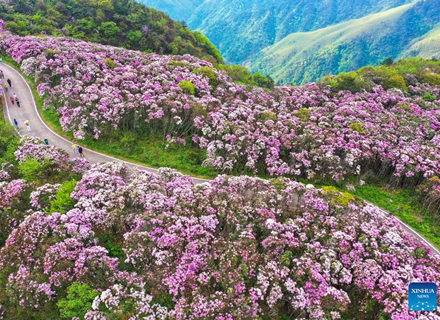Xinhua Headlines-Xi Focus: Xi Leads China's Fight Against Desertification with Historic Change
BEIJING, June 18 (Xinhua) — President Xi Jinping has led resolute combat against desertification, with "a historic change" made amid the country's passionate exploring for ways to curb the expansion of deserts.
More than half of China's manageable desertification land has been restored over the past decade, the National Forestry and Grassland Administration (NFGA) said on Friday, the World Day to Combat Desertification and Drought.
A historic change happened simultaneously. People were no longer forced into a corner by the desertification but managed to contain it through afforestation.
The desertified land area in China has been reduced by more than 4.33 million hectares since 2012. A series of significant projects gradually built a green ecological barrier along the sandstorm line in northern China. In particular, the three primary sandy areas of Maowusu, Hunshandake, and Horqin, and the surrounding areas of the Kubuqi Desert, have been transformed into an oasis.
Such achievements came along as President Xi Jinping has stressed the need to adopt a holistic approach to the conservation and restoration of mountain, river, forest, farmland, lake, grassland, and desert ecosystems.
He emphasized bringing "deserts" into the work for ecological conservation when joining a deliberation with national lawmakers from north China's Inner Mongolia Autonomous Region in 2021.
China has bolstered sand control credentials by making tremendous efforts to improve relevant laws, exploring new techniques, and launching greening projects.
Xi personally walks the talk, devotes himself to the groundwork, and pushes the agenda in person.
Knowing Desertification Control Well
Sand control is always a topic during Xi's discussions with lawmakers from the Inner Mongolia Autonomous Region during the country's annual national legislative meetings.
He urged the region boasting of forests, grasslands, wetlands, rivers, lakes, and deserts to take an integrated approach to improve local ecology in 2019 and debriefed a lawmaker last year on preventing deserts in Bayannur from encroaching the Yellow River in the east.
During these discussions, he underlined the importance of creating top-level designs in ecological treatment and doing good research work, warning that inadequacy could lead to results poles apart from what was supposed to be achieved.
Xi has conducted multiple field trips to areas severely hit by sand damage, including Ningxia, Gansu, and Hebei.
During a 2019 visit to Babusha Forest Farm in the northwestern province of Gansu, he joined local people plowing the sandy land. Using a trench digger skillfully, Xi plowed a two-meter-long trench in the sandy area with the workers in a few moments.
Babusha Forest Farm, located in northwest China's Gansu Province, had long been plagued by severe sandstorms. After years of sand control, the dry and barren land is now covered by vegetation.
Seeing the enormous transformation in this place, Xi praised the workers as "modern-day Yu Gong" for their persistent efforts in controlling sand and transforming the desert into an oasis. Yu Gong, the protagonist of an ancient folktale, determinedly tried to move mountains blocking the path in front of his home and eventually succeeded.
When the president delivered his New Year's speech in 2020, Guo Wangang, a worker from the forest farm, felt a warm flow through his heart as he saw on the screen the picture he had taken with the president and other farm workers on the bookshelf in the back.
Like Babusha Forest Farm, green miracles have been seen in many other deserts in the country over the years. Thanks to afforestation efforts, 64 million hectares of trees have been planted in China over the past decade. The country's forest coverage has reached 23.04 percent, up 2.68 percentage points from 2012.
Earlier data showed the area of desertified land in the country has shrunk by an annual average of 242,400 hectares. It indicates a reversal from the late 1990s when desertified land expanded by 1.04 million hectares annually.
Contributing to a Green World
Desertification remains one of the most pressing issues facing humankind. Data shows that more than 2 billion people from 167 countries and regions are still under desertification threat.
Thanks to years of sand control efforts, China has been quite prominent globally, with the Kubuqi Desert being an excellent case.
The Kubuqi Desert is China's seventh-largest desert, situated in Inner Mongolia Autonomous Region. About 30 years ago, the desert was a "sea of death" for even birds. The constant expansion of the desert forced many people to migrate. Those who remained lived mostly under the poverty line.
But years of greening efforts made more than 646,000 hectares of desert lush green, with restored biodiversity and noticeably improved ecology. These efforts also lifted more than 100,000 people out of poverty.
In 2015, the Kubuqi afforestation community won the Champions of the Earth award, the highest environmental honor of the United Nations.
"Containing desertification in the Kubuqi desert offers China's experience in environmental treatment as well as achieving the 2030 Agenda goals," Xi said in a congratulatory letter to the 7th Kubuqi International Desert Forum in 2019.
The Kubuqi model has been the epitome of China's years of exploration in scientific desertification control. Over decades, China has enacted laws to prevent and control desertification. These include the world's first law to tackle desertification and the ban on natural forest logging, building a green barrier in the legal system.
Key ecological projects, including protecting shelterbelt and natural forests, especially those in the northwest, northeast, and northern China and along the Yangtze River, have also been carried out, turning more barren soil into oases.
In addition, China actively fulfilled its obligations under the United Nations Convention to Combat Desertification, carried out exchanges and cooperation with Belt and Road countries, and established an international knowledge management center for desertification prevention and control.
"We do everything we can to conserve the ecological system, intensify pollution prevention and control, and improve the living and working environment for our people," Xi said at the Annual Meeting 2022 of the World Economic Forum.
Looking forward, China will continue to ban the use of the most vulnerable desertified lands, strengthen the development of national desert parks, and optimize the compensation system for desert ecological protection.
By 2025, China will have a total of 2 million hectares of desertified land sealed off for protection, with more than 6 million hectares of sandy land newly treated and 1.3 million hectares of rocky-desertification land harnessed, said the NFGA.
(Source: Xinhua)
Please understand that womenofchina.cn,a non-profit, information-communication website, cannot reach every writer before using articles and images. For copyright issues, please contact us by emailing: website@womenofchina.cn. The articles published and opinions expressed on this website represent the opinions of writers and are not necessarily shared by womenofchina.cn.








 WeChat
WeChat Weibo
Weibo 京公网安备 11010102004314号
京公网安备 11010102004314号